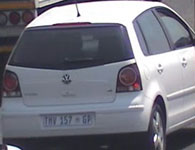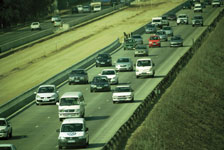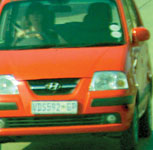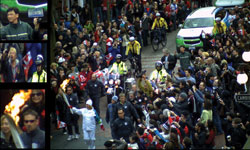
Human research has shown that the maximum time an operator can realistically concentrate on a monitor or screen is 20 minutes.
They have been trained to pick up on situations that might develop and have the ultimate decision as to an event taking place. The success or failure of the control room operation depends heavily on the operator’s ability to see or miss key events and take relevant actions. The balance between human operation against newer technologies is now surely a question that needs to be addressed.
Current situation
There are Urban surveillance projects in most of South Africa’s major cities. These extend from a few cameras to many hundreds of cameras requiring the employment of a number of operators and managers to ensure successful operation. This is mainly because, in most of our control rooms pan, tilt and zoom (PTZ) cameras have been deployed to enable an operator to pick up an overview of an event, zoom in to identify the event and then move out to gain an overall scenario so that when evaluation of the event takes place the assessor can clearly understand what has gone on. In some control rooms there can be more than 100 PTZ cameras; however only one camera can be operated by one operator at one time. Even if there are six operators and perhaps two managers, only eight out of the 100 plus PTZ cameras are in practical use at any one time. The rest of the PTZ cameras are on preset tours covering the most likely points of interest and these are recorded onto a digital or network video recorder (NVR) and can be accessed and assessed later. Is this a relevant statement and do we really capture the key events of a situation? We show off our successes, however how often do we miss the critical event?
Case 1. In 2008 there was an incident where a woman was raped at an intersection. The information was captured on the PTZ camera and noted by the operators and manager. They believed that it was a regular meeting between two lovers and merely recorded the event, not bothering to check the registration number of the vehicle or zoom in to see if there was any attempt from either party to show distress or panic. The incident was highlighted when the woman filed a complaint with the police and the resultant footage was unable to provide any additional evidence to the case.
Case 2. A major shopping mall car park employs 10 pan tilt and zoom dome cameras to secure the open parking area. There are two operators during peak hours to manage the 10 PTZ cameras; yet as many as four vehicles can be stolen each weekend from the car park without any footage being captured on camera. The mall has resorted to employing more security guards to increase the physical presence and chosen to deactivate the car park ticketing and access control to ensure that each and every vehicle is personally checked by a security guard before his colleague manually opens the gate to allow exit.
Key points
* PTZ dome cameras have a maximum effective range of 70–90 metres (Figure 1) depending on the lens.

* If a dome is working in one area, all other areas are not recorded. What you see is what you get.
* A dome camera has one operator; if the operator misses something, no one else can see it.
* When there are multiple cameras on preset tours your recorded footage becomes your main evidence.
* With terabytes of storage created by weeks or months of events, how good is the recorded material for investigative or prosecution purposes.
* Expensive cameras are often parked to watch their manhole covers for cable theft than being used in their primary role.
The solution
The advent of high definition cameras with their wide angle and longer focal ranges now offers city and urban surveillance a far more powerful tool for covering large areas in high resolution. With the innovative use of megapixel IP surveillance cameras we can cover a range of scenarios that replace multiple cameras or a single PTZ camera and provide constant 24/7 live or recorded views of a targeted field of view. We quantify this as Pixels on Target, a simple concept pioneered by Avigilon and other vendors in the high definition and megapixel surveillance space, ensuring a reliable system design by providing a verifiable metric on image detail.
For example using a 5 megapixel (MP) high definition camera with a 5 mm lens enables us to cover a 60° field of view providing 20 m of coverage across a street at 15 m range with an effective 130 pixels on target; sufficient for facial or licence plate identification. At a street intersection this would comfortably provide five or six lanes of intersection overview with the ability to zoom in through software multiple times by each and every operator to view live or recorded footage with the highest of detail. If we view a motorway scene (Figure 2) we could cover similar lanes at a set distance that would provide identification of every vehicle and its licence plate; plus those vehicles without licence plates that could be pulled over and prosecuted further down the road.


Consider that our 5 MP HD camera replaces up to 12 analogue cameras and the 16 MP HD Professional camera can replace up to 52 analogue cameras. We can comfortably state that with the labour, installation, cabling and subsequent monitoring that we can provide a sizeable saving on most new installations. Even using our high definition JPEG2000 encoders will provide significant savings on legacy system upgrades and an improved picture quality with our full software interface.

The key to the use of megapixel high definition cameras is the ability to stream the video at an image quality sufficient for pixels on target identification. Avigilon has used the JPEG2000 compression algorithm that provides a selectable visually lossless video stream. Through the use of the JPEG2000 compression technology we can choose what images we wish to view and thus change the bandwidth implications of streaming full video back to a central location thus answering the critics who regularly cite bandwidth as a limitation to using megapixel cameras. In reality, just as we can calculate the pixels on target equation to provide a correct field of view for the quality of image required, so we can adjust compression, quality of display and speed of frame rate to enable a measured stream to the control room.
Avigilon has taken into account the legacy analogue systems currently installed and therefore provides a four channel encoder, well priced, to be able to stream multiple cameras into the Avigilon Control Centre (ACC). The ACC does provide the ability to control PTZ cameras with the use of a USB joystick or within the image displayed with on screen direction. Add to this the ability to accommodate current IP products such as Axis, Arecont Vision, Panasonic, Sony, Samsung and Sightlogix, with Mobotix, Sanyo and ONVIF Cameras being added shortly provides a platform that is truly remarkable.

© Technews Publishing (Pty) Ltd. | All Rights Reserved.